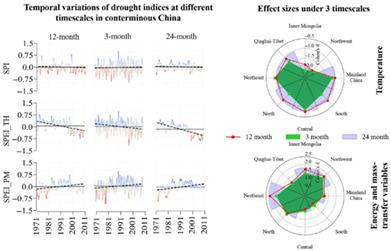当前位置:
X-MOL 学术
›
Int. J. Climatol.
›
论文详情
Our official English website, www.x-mol.net, welcomes your feedback! (Note: you will need to create a separate account there.)
Assessing the effects of climate variable and timescale selection on uncertainties in dryness/wetness trends in conterminous China
International Journal of Climatology ( IF 3.9 ) Pub Date : 2021-01-12 , DOI: 10.1002/joc.7005 Tianxiao Ma 1 , Yu Liang 1, 2 , Michael G. Sunde 3 , Matthew K. Lau 1 , Bo Liu 1 , Mia M. Wu 2 , Hong S. He 3
International Journal of Climatology ( IF 3.9 ) Pub Date : 2021-01-12 , DOI: 10.1002/joc.7005 Tianxiao Ma 1 , Yu Liang 1, 2 , Michael G. Sunde 3 , Matthew K. Lau 1 , Bo Liu 1 , Mia M. Wu 2 , Hong S. He 3
Affiliation

|
Analysing dryness/wetness trends, which is typically achieved by examining drought indices, is an essential approach for assessing extreme climate events. However, since there are differences among studies in terms of selected climate variables and timescales used to calculate drought indices, there is uncertainty regarding the magnitude and direction of the dryness/wetness, trend even for the same region. We used 40 years weather station data (1970–2010) and studied the uncertainties of dryness/wetness trends in conterminous China. The effects of selected climate variables, timescales and their interaction on the dryness/wetness trends were quantified by comparing the Standardized Precipitation Index, Standardized Precipitation Evapotranspiration Index (SPEI) with the Thornthwaite equation and SPEI with the Penman–Monteith equation at 3‐, 12‐ and 24‐month timescales. The results indicated that (a) higher uncertainties occurred in relatively arid and humid regions; (b) timescale tended to exaggerate the effect of climate variables, even though its effect was substantially lower than climate variables; (c) relative humidity and precipitation were the primary climate variables affecting observed dryness/wetness trend uncertainties. Since the key climate variables changed depending on the selected timescale, the role of timescale should be further examined the Inner Mongolia and Northeast regions. In general, the study results suggest that the trend analysis of dryness/wetness should include the interaction of both climate variable and timescale selection, particularly when a single drought index is used to estimate the dryness/wetness trend in diverse regions.
更新日期:2021-01-12


























 京公网安备 11010802027423号
京公网安备 11010802027423号